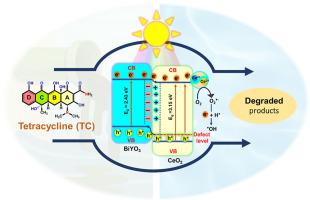在可见光照射下降解四环素的 CeO2/BiYO3 光催化剂
IF 5.6
2区 材料科学
Q1 MATERIALS SCIENCE, CERAMICS
引用次数: 0
摘要
光催化作为一种减少水中抗生素污染的有效方法受到了广泛关注。在本研究中,我们以四环素(TC)为模型污染物,制备并研究了 CeO2/BiYO3 系统的光降解效率。与纯 BiYO3 和 CeO2 相比,复合材料表现出明显更高的光催化活性,证明了它们作为有效光催化剂的潜力。对带电位的详细研究表明,两种半导体形成了 II 型异质结,增强了电荷分离。此外,Ce3+/Ce4+氧化还原偶的存在可作为电子捕获点,通过减少电子-空穴重组提高光催化性能。催化剂仅在第一个周期达到峰值效率。然而,一个简单的退火过程就能有效地将催化剂再生到原来的效率,这表明 CeO2/BiYO3 复合材料可以重复使用,而且活性损失极小。此外,我们还研究了纯 BiYO3 和 CeO2/BiYO3 复合材料不同的光降解机制。我们的研究结果让我们深入了解了异质结构的形成如何影响光催化过程。这些发现对于今后设计和开发相关的异质结构光催化剂,提高其降解各种污染物的效率具有重要价值。本文章由计算机程序翻译,如有差异,请以英文原文为准。


CeO2/BiYO3 photocatalyst for the degradation of tetracycline under visible light irradiation
Photocatalysis has received extensive attention as a promising method for reducing antibiotic contamination in water. In this study, we prepared and investigated the photodegradation efficiency of the CeO2/BiYO3 system, using tetracycline (TC) as a model pollutant. The composites demonstrated significantly higher photocatalytic activity compared to pure BiYO3 and CeO2, demonstrating their potential as effective photocatalysts. A detailed investigation of the band potentials indicated that the two semiconductors form a type II heterojunction, enhancing charge separation. Furthermore, the presence of the Ce3+/Ce4+ redox couple serves as an electron trap site, improving the photocatalytic performance by reducing electron-hole recombination. The catalyst achieved peak efficiency only during the first cycle. However, a simple annealing process effectively regenerated the catalyst to its original efficiency, suggesting that the CeO2/BiYO3 composite can be reused with minimal loss of activity. Additionally, we examined the distinct photodegradation mechanisms of pure BiYO3 and the CeO2/BiYO3 composite. Our results provide insights into how the formation of heterostructures influences photocatalytic processes. These findings are valuable for the future design and development of related heterostructure photocatalysts, aiming to enhance their efficiency for the degradation of various pollutants.
求助全文
通过发布文献求助,成功后即可免费获取论文全文。
去求助
来源期刊

Ceramics International
工程技术-材料科学:硅酸盐
CiteScore
9.40
自引率
15.40%
发文量
4558
审稿时长
25 days
期刊介绍:
Ceramics International covers the science of advanced ceramic materials. The journal encourages contributions that demonstrate how an understanding of the basic chemical and physical phenomena may direct materials design and stimulate ideas for new or improved processing techniques, in order to obtain materials with desired structural features and properties.
Ceramics International covers oxide and non-oxide ceramics, functional glasses, glass ceramics, amorphous inorganic non-metallic materials (and their combinations with metal and organic materials), in the form of particulates, dense or porous bodies, thin/thick films and laminated, graded and composite structures. Process related topics such as ceramic-ceramic joints or joining ceramics with dissimilar materials, as well as surface finishing and conditioning are also covered. Besides traditional processing techniques, manufacturing routes of interest include innovative procedures benefiting from externally applied stresses, electromagnetic fields and energetic beams, as well as top-down and self-assembly nanotechnology approaches. In addition, the journal welcomes submissions on bio-inspired and bio-enabled materials designs, experimentally validated multi scale modelling and simulation for materials design, and the use of the most advanced chemical and physical characterization techniques of structure, properties and behaviour.
Technologically relevant low-dimensional systems are a particular focus of Ceramics International. These include 0, 1 and 2-D nanomaterials (also covering CNTs, graphene and related materials, and diamond-like carbons), their nanocomposites, as well as nano-hybrids and hierarchical multifunctional nanostructures that might integrate molecular, biological and electronic components.
 求助内容:
求助内容: 应助结果提醒方式:
应助结果提醒方式:


